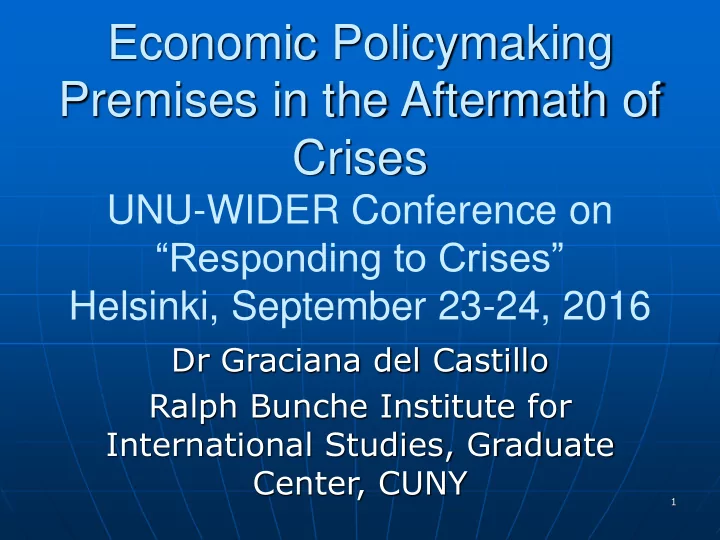

Economic Policymaking Premises in the Aftermath of Crises UNU-WIDER Conference on “Responding to Crises” Helsinki, September 23-24, 2016 Dr Graciana del Castillo Ralph Bunche Institute for International Studies, Graduate Center, CUNY 1
Table 1: Transition From War to Peace Transition: From: To: • Improving public security Security Violence and insecurity • Creating or improving security institutions (civilian police + army) • Developing a participatory and inclusive government Political Lawlessness and • Promoting respect for the rule of law and for human, political exclusion property, and gender rights • Promoting national reconciliation to Social Sectarian/ethnic, [National reconciliation] religious, ideological or reintegrate war-affected groups into society and class confrontation rebuilding the social fabric of the communities after civil war or other • Developing an institutional framework to address differences through peaceful ways • Establishing basic macro/micro framework Economic Ruined and underground • Rehabilitating infrastructure and services [Economic Reconstruction, war economies, state- • Creating a viable economic environment for rural Economics of Peace, controlled policies and Political Economy of Peace] large macroeconomic development and entrepreneurship • Eradicating illicit activities imbalances (drugs/corruption) 2 Source: del Castillo, G., Obstacles to Peacebuilding (London: Routledge, 2017)
Diagram 2.1 REVERSE CAUSALITY Political Security Economic Social 3
PREMISE 1: Economic reconstruction is not development as usual Political (peace) > Economic (development) First-best (optimal) economic policies not possible/desirable 4
PREMISE 2: Policymaking during crises is distinctly different from normal development 5
Table 2: Economic Policymaking In Countries in Normal In Countries in Post-Conflict or Development Other Crises Medium and long-term framework Requires (distortionary) emergency programs Low and stable foreign assistance Sharp spikes in foreign assistance Application of the “development Application of the “reconstruction principle” principle” Government establishes rule of law Foreign troops and police support rule of law Political involvement of Intensive and often intrusive political international community involvement considered interference 6 Source: del Castillo, G., Obstacles to Peacebuilding (London: Routledge, 2017)
PREMISE 3: Economic policies and institutions must be simple, transparent, flexible, sequenced, and realistic Avoid corruption, inefficiency, foreign consultants Reflect legitimacy and financial resources Flexibility necessary to deal with aid delays 7
PREMISE 4: The private sector must be effectively engaged in the peace process Economic expertise needs in peace negotiations Private sector key actor in economic reconstruction 8
PREMISE 5: The impact of aid must be maximized through effective, integrated, sequenced, and non-corrupt practices Spikes in aid: minimize corruption Channel aid through budget Do not conflate Hum Aid/Rec Aid Move from aid to FDI 9
PREMISE 6: Peace processes must contemplate a fair use of natural resources Compensation to losers from peace agreements to avoid “spoilers” 10
PREMISE 7: Rapid growth is not enough; growth must be inclusive, dynamic, and sustainable Level-playing field for large majority From subsistence to higher productivity Production sustainable once aid withers 11
PREMISE 8: Create an appropriate yardstick to measure success Policies and projects must be judged qualitatively by whether they contribute or not to peacebuilding, rather than on purely economic/financial criteria. 12
Recommend
More recommend